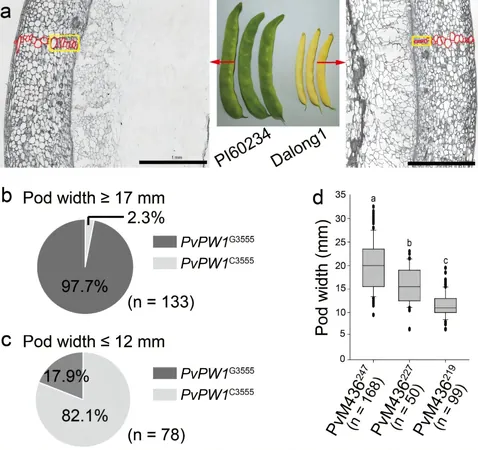
Groundbreaking Discovery: Scientists Unravel Gene Controlling Pod Width in Snap Beans
2024-10-29
Author: Wei Ling
Groundbreaking Discovery: Scientists Unravel Gene Controlling Pod Width in Snap Beans
In a remarkable scientific breakthrough, researchers have pinpointed a gene that plays a crucial role in determining the pod width of snap beans (Phaseolus vulgaris L.), a vital vegetable crop enjoyed worldwide. The immature pods are the primary harvest, with their dimensions—length, width, and thickness—significantly impacting both yield and the efficiency of manual picking, particularly in regions like China, where traditional harvesting methods are still predominant.
Led by eminent researchers Prof. Xia Zhengjun and Prof. L. Yanhua from the Northeast Institute of Geography and Agroecology of the Chinese Academy of Sciences, this study, recently published in the prestigious Journal of Genetics and Genomics, reveals the intricacies of the PvPW1 gene. This gene is directly linked to variations in pod width, thickness, and overall cross-sectional size, providing new avenues for enhancing agricultural practices.
To explore the genetic factors influencing pod width, the team created a bi-parental F1 mapping population by crossing two distinct cultivars: PI60234, known for its wide, flattened pods, and Dalong1, characterized by narrow, oval pods. Through meticulous genotyping and phenotyping of the resulting recombinant plants, they successfully identified a key gene, Phvul.006G072800. This gene encodes the protein β-1,3-glucanase 9 and is directly responsible for the quantitative trait locus linked to pod width, identified as PvPW1.
Their association analysis across 17 bi-parental F2 populations revealed a striking correlation between the PvPW1G3555C genotype and increased pod width. Impressively, 97.7% of the wide pod accessions exhibited the favorable PvPW1G3555 allele, whereas 82.1% of the narrow pod accessions carried the alternative PvPW1C3555 allele. This trend indicates a strong selection pressure on the PvPW1 gene throughout the breeding of common beans.
In a further breakthrough, the researchers leveraged resequencing data from 59 common bean cultivars to uncover an 8-base pair deletion within an intron linked to the PvPW1C3555 allele. This led to the development of the InDel marker designated as PvM436, a crucial tool for breeders aiming to innovate snap bean varieties.
Genotyping of 317 common bean accessions utilizing the PvM436 marker unveiled that those with the PvM436247 and PvM436227 alleles possess significantly wider pods compared to those with the PvM436219 allele. This establishes PvM436 as a reliable marker for molecular breeding strategies aimed at enhancing pod size and yield in snap beans.
As global demand for efficient farming practices increases, the identification of PvPW1 underscores its potential importance not just in research laboratories, but also in farming fields across the world. This discovery may revolutionize the snap bean industry and pave the way toward higher yields with better-quality produce, ultimately benefiting farmers and consumers alike. Stay tuned for more updates as this exciting research unfolds!
 Brasil (PT)
Brasil (PT)
 Canada (EN)
Canada (EN)
 Chile (ES)
Chile (ES)
 Česko (CS)
Česko (CS)
 대한민국 (KO)
대한민국 (KO)
 España (ES)
España (ES)
 France (FR)
France (FR)
 Hong Kong (EN)
Hong Kong (EN)
 Italia (IT)
Italia (IT)
 日本 (JA)
日本 (JA)
 Magyarország (HU)
Magyarország (HU)
 Norge (NO)
Norge (NO)
 Polska (PL)
Polska (PL)
 Schweiz (DE)
Schweiz (DE)
 Singapore (EN)
Singapore (EN)
 Sverige (SV)
Sverige (SV)
 Suomi (FI)
Suomi (FI)
 Türkiye (TR)
Türkiye (TR)
 الإمارات العربية المتحدة (AR)
الإمارات العربية المتحدة (AR)